From January to May 2015 I went to a boarding school in the north of Norway, in Lofoten. The school is located in a small fishing-town and cultural center called Kabelvåg, not far from the islands capitol (Svolvær) and just above the Arctic Circle.
The school activity
«Lofoten Folkehøgskole», the name of the school, is specialized on photography and outdoor activities like surfing, climbing and skiing. My class had the untranslatable name «vinterfriluftlsiv», which means, I’ll try anyways, something like winter outdoor life.
We were ten pupils from all over Scandinavia, and we were all completely different from one another; different sets of skills and also the expectations to the course varied a lot. But as soon as we had gotten to know each other, we were a great team on the many ski tours we were on together!
In school we learned everything we had to know to survive in the Norwegian winter; all from avalanches to keeping warm. The classes were really application-oriented, so most of the things we either learned outside or got to test in the field as soon as we had absorbed the theory. When we learned about navigation, for instance, we localized mountains and other landmarks on the map and figured out different angles with our compasses. Then we went outside on a ski tour and had to find the cabin we were to stay at, just with a few coordinates, map and compass in, at the time, unknown terrain. It was not an easy task but it worked out in the end, and we had acquired the basics of navigation in one day!
Much of the time in the classroom we devoted on planning the next ski tour. Also in this area we made huge progress: to plan a two-day tour in the beginning took us just as long as figuring out the basics of our 15-day “Spitsbergen-tour” in the end…
We were also often seen in the kitchen, preparing food for the tours. We had quickly learned what not to bring on a winter tour: fruit, pizza, bread and other foods containing water. Jam and peanut butter worked fine though, for some reason, so these became our primary spreads – on pancakes and “loganbread” (an energy-rich, waterless type of bread we were baking ourselves and eating most of the time on tours). For dinner, we created varied, easy-to-prepare menus with different kinds of grain, dried vegetables, meat and fish. So we always had good and, maybe even more importantly, plenty of food with us (on Spitsbergen: about 45kg for four people, a lot of it dried stuff!).
The locale
The “folkehøgskole” was much more than the courses and tours (although these contributed a great deal to make this half year unforgettable!): It was a great social setting for own ideas and initiatives – many afternoon or day-filling ski tours were undertaken spontaneously, also hikes to the surrounding mountains for a gorgeous view (when snow conditions permitted it). Likewise we would embark on fishing or rowing tours with the school’s boats, exploring the harbor or the off the coast islands.
Evenings allowed for playing board games, discussing politics or philosophizing, watching a good movie or heating up the sauna at the waterfront. That always included several dips into the icy ocean, even in January… As it grew warmer, lighting a campfire and grilling marshmallows became popular as well. A gymnasium also made bad-weather activity possible; football, volleyball, badminton, hockey, climbing and circuit training plus a lot more – there was often so much going on that the difficulty was to choose between all the options…
Naturally I did not have equally much to do with all the students, but everyone were super friendly and open and made it really easy for me and my classmates to integrate into the existing community (everyone else had been there for half a year longer than us). I made many great friends with whom I undertook all the named-above adventures and many more – a real privilege! I have so many great memories from that time, and unfortunately summarizing them here does not even come close to the real thing…
Thanks, everyone, for making this time so special!
The setting
Lofoten is an amazing place: Between a rough sea and raw mountains there is a narrow strip of (more or less) arable and inhabitable land. One road connects the tip of this archipelago with the main land, through a set of tunnels and across numerous bridges. Otherwise it is wiggling around mountains and along bays, approximately following the shoreline. That makes navigation easy: there are only two directions. Alongside the road and at the end of byroads there are sleepy fishing towns and small settlements that seem as though they have not quite made it into the 21st century yet. It is an idyllic place, especially in winter and spring, before hordes of tourists invade it, turning the quiet mountains into busy anthills and the road into a 100km parking lot, or so I have been told ;)
When I arrived there in the beginning of January, the sun was still gone. It was not getting light before ten o’clock, and a few hours later it was night again. But the sun returned quickly and the lengthening of the days was palpable. The first weeks the lighting was the most magnificent: When sunrise at noon turned into sunset the sky displayed an array of vivid colors that stayed until long after the sun had vanished below the horizon, then gradually fading into darkness. The shades of pink, orange and purple showed such intensities that I had not thought possible until then – sitting on the shore, watching this spectacle was an almost unreal experience.
The sun quickly climbed higher and higher, and by the time I left the islands in May it was lighter in the middle of the night than it had been at noon in January.
But as long as the nights were still dark there was always the chance to see northern lights. We spent long hours standing outside in the snow, gazing upwards, freezing. But it was rewarding, at least sometimes. Most often the northern lights were hard to distinguish, just a pale inanimate green glowing something, not unlike clouds, except for their color. But occasionally this pattern changed: the light grew in intensity and started moving and transforming shape. Then, always just for a few minutes at a time, it exploded into rays of red, green and white light that were silently dancing across the sky and forming ever new patterns in quick succession. I hardly knew where to look and felt an incredible joy while marveling at this unearthly performance of nature.
It strikes me that Lofoten must always be a spectacular place – the black-and-white mountains in winter, a white band of snow and flowers below at the sea in a sunny spring, green-grass covering the mountains in summer and the colorful vegetation in autumn – so I will have to return!

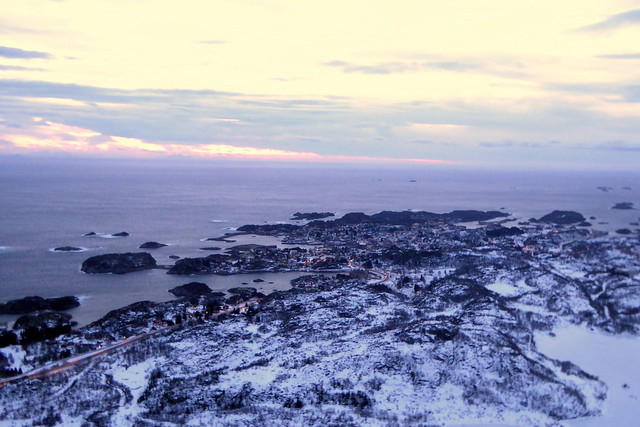
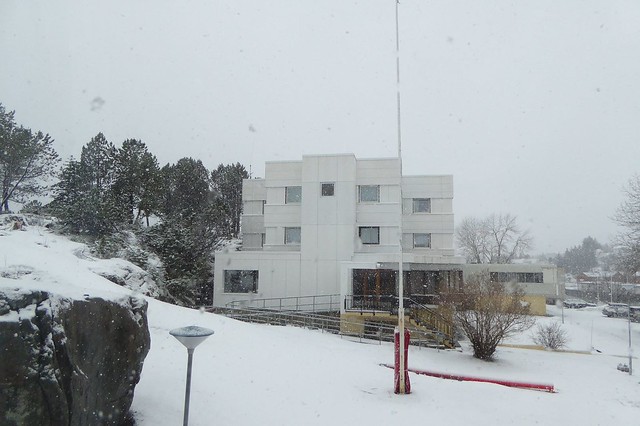
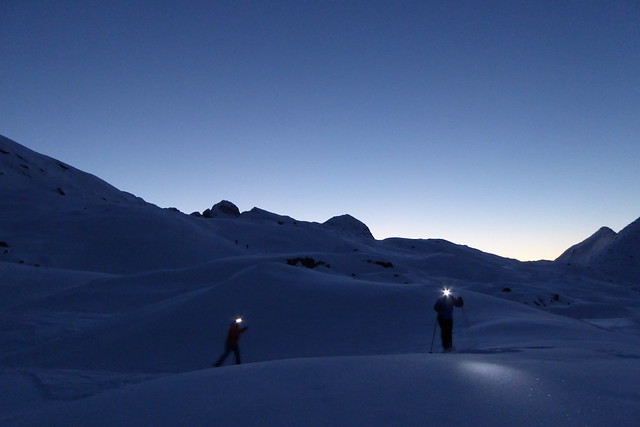
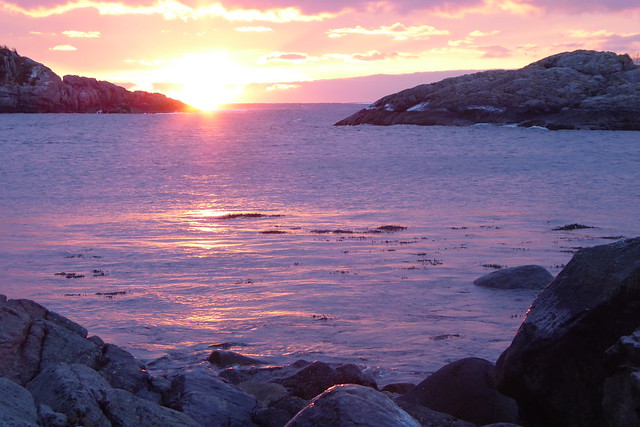
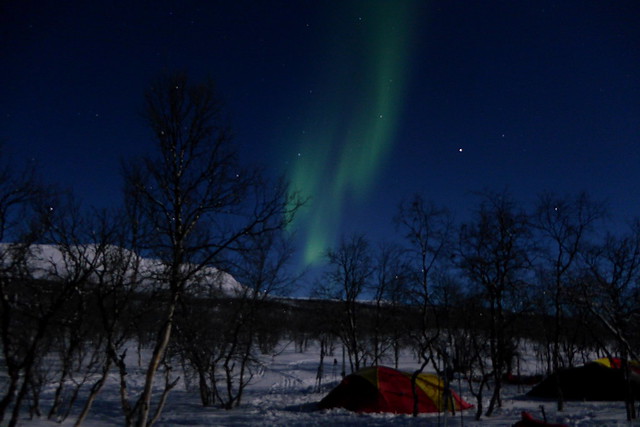
Where is a good place to live in Lofoten?
Gabriel! Håber at du har det fantastisk, og at din tur til Rusland som vel snart er nu, kommer til at være en oplevelse for livet! Jeg vil gerne sige tak, for at du har lavet denne fantastiske blog, sidder og smiler imens jeg læser den, og savner Lofoten og alle menneskerne:) Hilsen Hjalte
Hei, Gabriel!
Det var en billedrik og velskrevet beretning om tiden på folkehøgskolen Og flotte fotografier!
Klem fra mamma